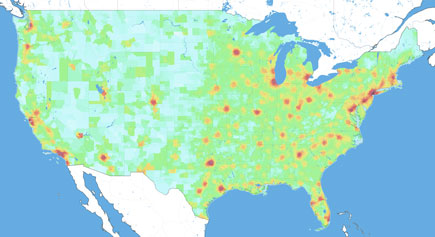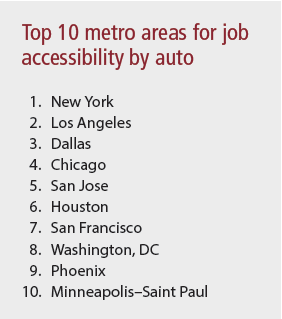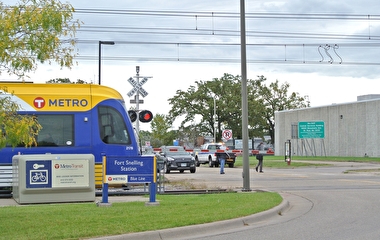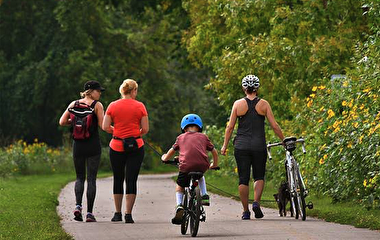Annually updated research from the U’s Accessibility Observatory ranks access to jobs by auto for the 50 largest (by population) metropolitan areas in the United States. According to the latest data, the Minneapolis–Saint Paul metropolitan area ranks 10th nationally. The study reports that the average worker traveling by auto in the Twin Cities metro can reach 976,018 jobs within 30 minutes. Total employment in the metro area is 1,745,960 (14th nationally).
The analysis also found that Minneapolis–Saint Paul ranks 26th in lost access to jobs because of traffic congestion. The average worker traveling by auto in the Twin Cities metro can reach 15 percent fewer jobs within 30 minutes during congested periods.
“This suggests that job accessibility is influenced less by congestion here than in other cities,” explains Andrew Owen, director of the Observatory. “Rather than focusing on how congestion affects individual travelers, our approach quantifies the overall impact that congestion has on the potential for interaction within urban areas.”
Accessibility to jobs by autoThe new rankings are part of the Access Across America study, which began in 2013. The rankings focus on accessibility, a measure that examines both land use and transportation systems. Accessibility measures how many destinations, such as jobs, can be reached in a given time.
“The Auto 2016 report provides baseline data for annual comparisons of accessibility change, both by the zone/block level and as an overall value for the region,” says Deanna Belden, director of performance, risk, and investment analysis with the MnDOT Office of Transportation System Management. “Certain areas with completion of large construction projects will be worth watching in the next couple of years, such as I-35W in Minneapolis, I-694 in Shoreview/Arden Hills, and Highway 610, among others.”
This year’s report—Access Across America: Auto 2016—presents detailed accessibility and congestion impact values for each of the 50 metropolitan areas, as well as detailed block-level maps that illustrate the spatial patterns of accessibility within each area.
The research is sponsored by the National Accessibility Evaluation Pooled-Fund Study, a multiyear effort led by MnDOT and supported by partners including the Federal Highway Administration and 10 additional state DOTs.
The Auto 2016 report and other Access Across America research reports for transit, walking, and soon, biking, are available on the Observatory website.






